Home>Garden Essentials>How Long Do Microgreens Take To Germinate
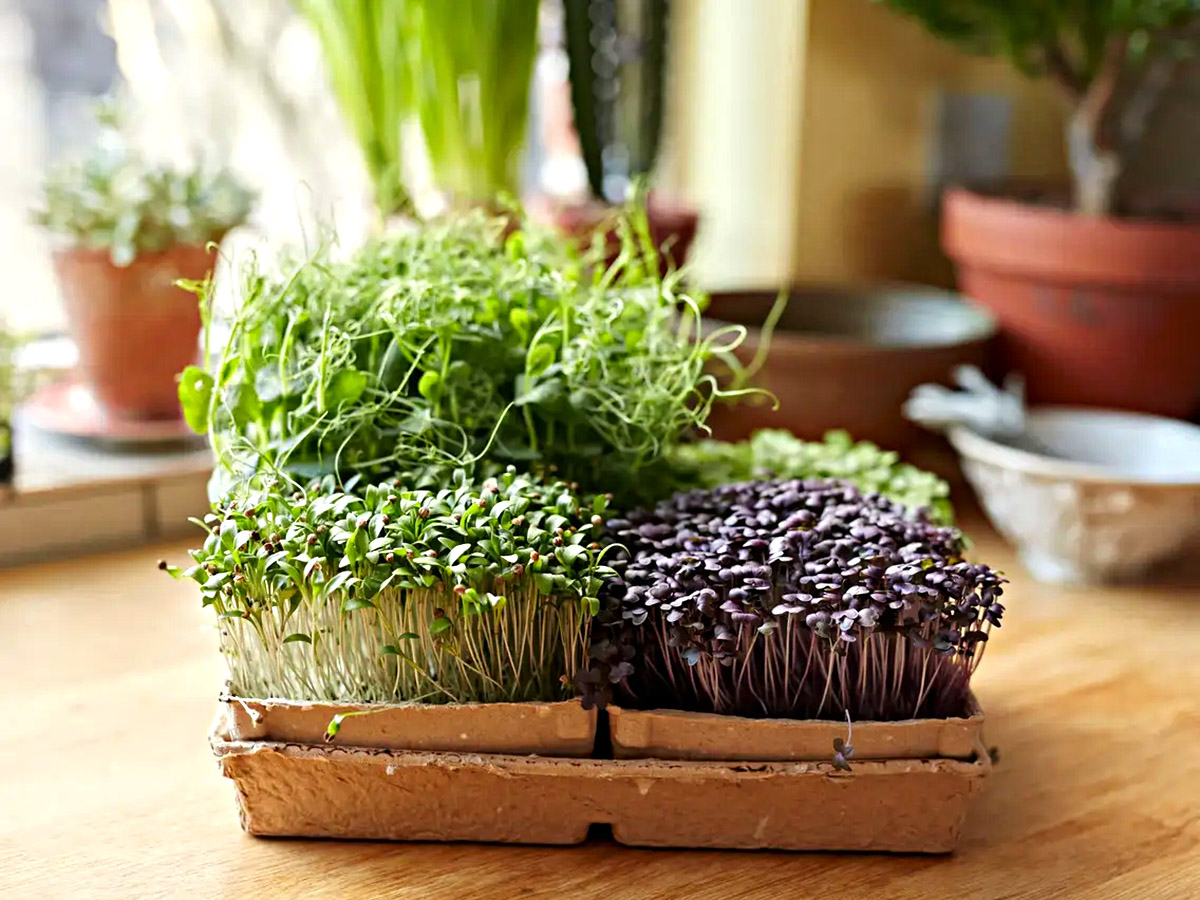

Garden Essentials
How Long Do Microgreens Take To Germinate
Modified: April 30, 2024
Discover how long it takes for microgreens to germinate in your garden. Get expert tips and advice on growing these nutritious greens at home.
(Many of the links in this article redirect to a specific reviewed product. Your purchase of these products through affiliate links helps to generate commission for Storables.com, at no extra cost. Learn more)
Introduction
Microgreens have gained popularity in recent years for their intense flavors, vibrant colors, and incredible nutritional density. These tiny, delicate greens are not only a delight for the taste buds but also a powerhouse of nutrients. If you’re new to the world of microgreens, you may be wondering: how long do they take to germinate? In this article, we will explore the germination process of microgreens and factors that affect their germination time.
Before we delve into the details of germination, let’s first understand what microgreens are. Microgreens are young edible seedlings of various vegetables, herbs, and greens. They are smaller in size than baby greens and are harvested at an early stage of growth, typically around 7 to 14 days after germination. Unlike sprouts, which are grown in water, microgreens are grown in soil or a growing medium, allowing them to develop their unique flavors and textures.
Key Takeaways:
- Microgreens typically take 7-14 days to germinate, but this can vary. Factors like seed quality, temperature, humidity, light, and watering play a role in the germination process.
- To grow healthy microgreens, use high-quality seeds, maintain proper moisture and ventilation, and provide suitable temperature and light conditions. Patience and observation are key to successful germination.
Read more: How Long Do Petunias Take To Germinate
What are Microgreens?
Microgreens are not just your ordinary greens – they are miniature versions of fully grown vegetables, herbs, and greens, packed with concentrated nutrients. These tiny greens are harvested at an early stage of growth, usually when they have developed their first set of true leaves. While they may be small in size, they possess an impressive array of flavors, ranging from mild and sweet to tangy and peppery.
One of the defining characteristics of microgreens is their vibrant colors. From radiant reds and purples to verdant greens and sunny yellows, these mini greens add a pop of visual appeal to any dish. Beyond their aesthetic appeal, microgreens offer a multitude of health benefits. Research has shown that they contain higher levels of vitamins, minerals, and antioxidants compared to their mature counterparts, making them a potent addition to any diet.
Microgreens come in a wide variety of flavors and textures, ranging from the delicate and tender leaves of cilantro and basil to the crisp and crunchy stems of radishes and broccoli. Some popular varieties of microgreens include sunflower, pea shoots, spinach, kale, arugula, and mustard greens. Each variety has a distinct taste profile, allowing you to experiment and add a burst of flavor to your favorite dishes.
Not only are microgreens nutrient-dense, but they are also incredibly versatile in the kitchen. They can be used as a garnish to elevate the visual appeal of a dish, added as a topping to salads and sandwiches, incorporated into wraps and rolls, or even juiced for a nutrient-packed shot. Their delicate textures and intense flavors make them a favorite among chefs and home cooks alike, providing a burst of freshness and complexity to any meal.
Now that we understand what microgreens are, let’s dive into the fascinating process of how they germinate and grow.
Germination Process
Germination is the process by which a seed begins to sprout and grow into a young plant. For microgreens, the germination process starts with soaking the seeds in water to awaken them from dormancy. This encourages the seed to absorb water, activate enzymes, and initiate the growth process.
Once the seeds have been soaked, they are typically spread evenly over a growing medium, such as soil or a specialized tray filled with a nutrient-rich medium. The seeds are lightly pressed into the medium to ensure good soil contact, which aids in moisture absorption. After sowing, the trays are covered with a clear lid or plastic wrap to create a humid environment, mimicking the conditions required for optimal growth.
During germination, the seeds begin to draw moisture from the surrounding environment. This triggers the activation of enzymes, which break down stored nutrients within the seed, providing the energy and building blocks necessary for the seedling to emerge. As the seedlings grow, they develop their first set of true leaves, which are the characteristic leaves of the specific plant variety.
The duration of the germination process varies depending on the type of microgreen and environmental conditions. On average, most microgreens take anywhere from 7 to 14 days to fully germinate. However, some varieties may germinate as quickly as 3 to 5 days, while others can take up to 21 days. It’s important to note that the germination time is just the first stage of growth, and the microgreens will continue to develop and mature after germination.
Light is an essential factor in the germination process. Once the seedlings have emerged from the soil, they require adequate light to fuel their growth and development. Placing the trays in a location with sufficient natural or artificial light is crucial. Additionally, proper airflow and ventilation are essential to prevent the growth of mold or diseases that can affect the young seedlings.
As the microgreens grow, they should be regularly monitored and watered to maintain optimal moisture levels. Overwatering or allowing the growing medium to dry out completely can negatively impact germination and growth. It’s important to find the right balance and ensure that the microgreens receive adequate moisture without becoming waterlogged.
Now that we have a better understanding of the germination process, let’s explore the factors that can influence the time it takes for microgreens to germinate.
Factors Affecting Germination Time
The germination time of microgreens can be influenced by several factors, both internal and external. Understanding these factors can help you optimize the germination process and ensure successful growth and development of your microgreens. Here are some key factors that affect germination time:
- Seed Quality: The quality and viability of the seeds play a significant role in germination time. Using fresh and high-quality seeds increases the chances of faster and more uniform germination. It is recommended to source seeds from reputable suppliers or harvest them from mature plants to ensure better germination rates.
- Temperature: Temperature is a crucial environmental factor that affects seed germination. Different microgreens have different temperature preferences for germination. Most microgreens thrive in temperatures ranging from 60 to 75 degrees Fahrenheit (15 to 24 degrees Celsius). Cooler temperatures can slow down germination, while warmer temperatures can speed it up. It’s important to maintain a consistent and appropriate temperature throughout the germination process.
- Humidity: Maintaining the right humidity level is essential for successful seed germination. The seeds require a humid environment to absorb moisture and initiate growth. High humidity levels can help prevent the seeds from drying out, especially during the early stages of germination. Using a clear lid or plastic wrap over the trays can create a humid microclimate. However, excessive humidity can promote the growth of mold or fungal diseases, so it’s important to monitor humidity levels and provide adequate ventilation.
- Light: Light is another vital factor that affects the germination process. While some seeds require light to germinate, others may prefer darkness. It’s important to research the specific light requirements of the microgreen variety you are growing. If light is necessary, ensure that the seedlings receive adequate light once they emerge from the soil. Positioning the trays near a bright window or using grow lights can ensure the seedlings receive the proper amount and intensity of light.
- Watering: Proper watering is essential for seed germination. Overwatering can lead to rotting or damping-off of the seeds, while underwatering can result in dryness and hinder germination. It’s important to water the trays consistently and evenly, making sure not to oversaturate the growing medium. The aim is to keep the soil moist, but not waterlogged.
By taking these factors into consideration, you can create the optimal conditions for seed germination and promote healthy growth and development of your microgreens. However, it’s important to note that germination times can still vary depending on the specific microgreen variety and other environmental factors.
Now that we know the factors that influence germination time, let’s explore the average germination time for some popular microgreen varieties.
Microgreens typically take 2-4 days to germinate. Keep the seeds moist and in a warm, well-lit area to encourage faster germination.
Average Germination Time for Different Microgreens
The germination time for microgreens can vary depending on the specific variety. Some microgreens have shorter germination times, while others may take a bit longer to sprout and develop. Below are the average germination times for a few popular microgreen varieties:
- Broccoli: Broccoli microgreens typically take around 4 to 6 days to germinate. They are known for their mild and slightly spicy flavor, making them a versatile addition to salads, sandwiches, and stir-fries.
- Radish: Radish microgreens are known for their quick germination. They typically sprout within 3 to 5 days. These vibrant greens have a peppery kick and are a popular choice for adding a burst of flavor to a variety of dishes.
- Sunflower: Sunflower microgreens are known for their nutty flavor and delightful crunch. They have a relatively longer germination time compared to some other varieties, usually taking around 7 to 10 days to sprout.
- Pea Shoots: Pea shoots are prized for their tender textures and sweet flavor. They are quick to germinate, usually within 3 to 5 days. These delicate microgreens are a delightful addition to salads, wraps, and sandwiches.
- Cilantro: Cilantro microgreens, with their fresh and citrusy taste, usually take around 7 to 10 days to germinate. These aromatic greens add a burst of flavor to salsas, soups, and Mexican-inspired dishes.
- Spinach: Spinach microgreens are known for their mild and slightly earthy flavor. They typically take around 5 to 7 days to germinate and are a nutritious addition to salads, smoothies, and sandwiches.
While these are the average germination times, it’s essential to note that actual germination can vary depending on factors such as temperature, humidity, and seed quality. It’s always a good idea to refer to specific instructions provided by the seed supplier or conduct your own experiments to determine the optimal germination time for the microgreens you are growing.
Now, let’s explore some tips for successful germination to ensure that your microgreens sprout and thrive.
Read more: How Long Do Cowpeas Take To Germinate
Tips for Successful Germination
To maximize germination success and achieve healthy, vibrant microgreens, it’s important to follow certain tips and best practices. Here are some essential tips for successful germination:
- Choose high-quality seeds: Opt for fresh, high-quality seeds from reputable sources. This ensures better germination rates and healthy seedlings.
- Pre-soak seeds: Soaking seeds before sowing can help speed up germination. Place the seeds in a bowl of water for a few hours or overnight to activate them.
- Use a suitable growing medium: Use a well-draining and nutrient-rich growing medium, such as potting soil or a specialized microgreen growing mix, to provide the ideal conditions for germination.
- Ensure adequate moisture: Keep the growing medium consistently moist but not waterlogged. Use a spray bottle or mist the surface regularly to maintain optimal moisture levels.
- Provide proper ventilation: Good airflow is crucial for preventing mold and disease. Remove the cover or lid once the seedlings have emerged, and ensure proper air circulation around the trays.
- Find optimal temperature: Maintain a consistent temperature range suitable for the specific microgreen variety. Most microgreens prefer temperatures between 60 and 75 degrees Fahrenheit (15-24 degrees Celsius) for optimal germination.
- Ensure adequate light: If your microgreens require light for germination, position the trays near a bright window or use grow lights to provide sufficient light intensity. Adjust the distance between the lights and seedlings to prevent leggy growth.
- Monitor and adjust watering: Regularly check the moisture levels of the growing medium. Avoid overwatering or letting the soil dry out completely. Adjust watering frequency as needed to maintain optimal moisture.
- Thin out seedlings: If the seedlings are crowded, gently thin them out after they have grown their first set of true leaves. This allows the remaining seedlings to have enough space for healthy growth.
- Be patient and observe: Germination times can vary, so be patient and observe the progress of your microgreens. Keep track of any issues or changes you notice and make adjustments accordingly.
By following these tips, you can increase your chances of successful germination and ensure healthy growth of your microgreens. Remember to pay attention to the specific requirements of the microgreen variety you are growing, and don’t be afraid to experiment and adapt your approach based on your observations and experiences.
Now that you are armed with these tips, go ahead and enjoy the rewarding process of growing your own microgreens!
Conclusion
Growing microgreens is a rewarding and enjoyable endeavor. These tiny greens not only add a burst of flavor and vibrant colors to your meals but also offer exceptional nutritional value. Understanding the germination process and factors that affect germination time is essential for successful growth and development of microgreens.
In this article, we’ve explored the germination process of microgreens, from seed soaking to the emergence of the first set of true leaves. We’ve also discussed the factors that can influence germination time, including seed quality, temperature, humidity, light, and watering.
We’ve learned that different microgreen varieties have varying germination times. Some may sprout within a few days, while others may take up to two weeks. It’s important to be patient and monitor the progress of your microgreens to determine the optimal germination time for each variety.
To ensure successful germination, we’ve provided valuable tips, such as using high-quality seeds, providing proper moisture and ventilation, maintaining suitable temperature and light conditions, and monitoring watering practices. Following these tips will help you achieve healthy and vibrant microgreens.
Microgreens are not only great for adding flavor and visual appeal to salads, sandwiches, and various dishes, but they also offer a concentrated dose of nutrients. Their nutrient density and unique flavors make them a favorite among health-conscious individuals and culinary enthusiasts.
So, whether you have a small garden or limited space, microgreens are a fantastic way to enjoy flavorful and nutritious greens right at home. With a little patience, attention to detail, and these tips in mind, you’ll be on your way to growing your own successful batch of microgreens.
Now it’s time to get your hands dirty, sow those seeds, and witness the magic of germination as your microgreens sprout and flourish!
Frequently Asked Questions about How Long Do Microgreens Take To Germinate
Was this page helpful?
At Storables.com, we guarantee accurate and reliable information. Our content, validated by Expert Board Contributors, is crafted following stringent Editorial Policies. We're committed to providing you with well-researched, expert-backed insights for all your informational needs.






0 thoughts on “How Long Do Microgreens Take To Germinate”